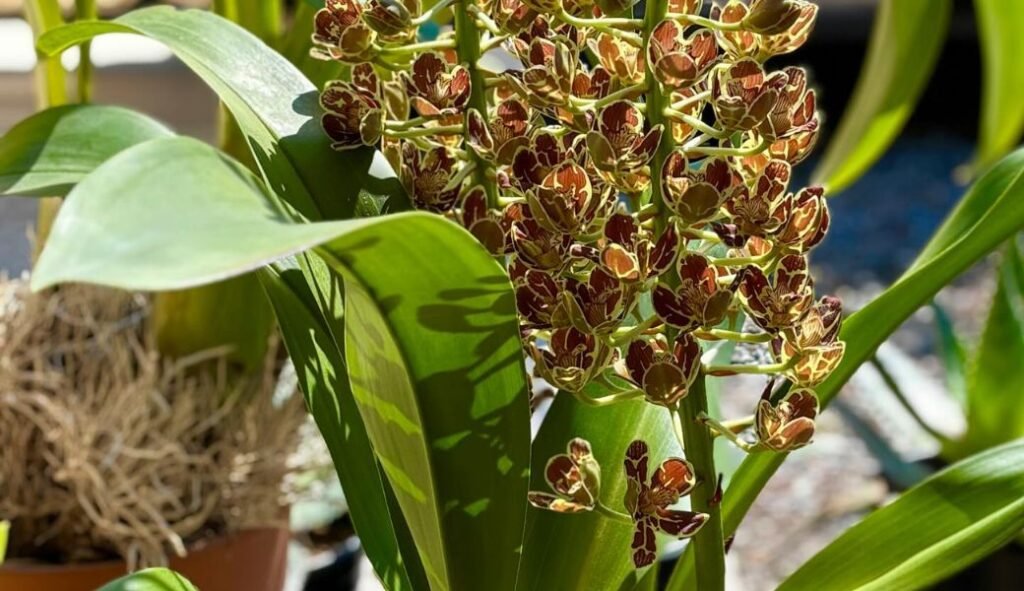
The name of the genus “Grammatophyllum” comes from two Greek words, “gramma” meaning “mark” and “phyllon” meaning “leaf”. The Grammatophyllum orchid genus comprises two different types of pseudobulb growth – one that is long and sugarcane-like and the other that is short and stout in shape. This species of orchid is so named because of the markings on their leaves and blooms. The flower inflorescences of these orchids can contain over 100 flowers, each measuring approximately four inches. Grammatophyllum orchids are epiphytic and are known for their ability to thrive in high levels of requirements.
About Grammatophyllum orchid
The most well-known species of Grammatophyllum orchid is the Grammatophyllum speciosum, also called the Giant Orchid due to its long pseudobulbs and most enlarged blooms. This species of orchid looks like the skin of a tiger, earning it the nickname “tiger orchid”. Its fragrant, yellow flowers with maroon or brown markings are an excellent site of lasting impression. This epiphytic plant can be found in places like Asia, the Philippines, and New Guinea. An excellent species, the Grammatophyllum scriptum with the green and brown combo is also known as the bell orchid. Other species like Grammatophyllum stapeliiflorum, and Grammatophyllum scriptum share similar characteristics as speciosum, with slightly smaller pseudobulbs and flowers in green, red, and other spotted colours.
The Grammatophyllum multiflorum is another species of orchid known for its long-lasting bloom and compact size, making it a great choice for indoor orchid growing. These orchids have a unique root system that is both airy and robust. The Grammatophyllum orchids are low-maintenance plants and grow quite fast. Green Grammatophyllum produces long-blooming, fragrant flowers with uniquely marked leaves that are highly sought after by orchid lovers. Some blooms of Grammatophyllum orchids last between one to six months, while others can last up to nine months. Due to their sugarcane-like foliage, these giant orchids are also called sugarcane orchids.
Lighting
Grammatophyllum Orchids require bright, indirect light or even full sun exposure to thrive. To grow them indoors, you can place them in areas with filtered light such as a south-facing window sill, patio, or balcony. When grown outdoors, shady spots are ideal. One way to know if the lighting is sufficient is by observing the lime-green colour of the leaves. These orchids benefit greatly from morning sunlight, but insufficient lighting can affect their blooming. If natural light is not enough, you can use artificial sources like fluorescent lights or LEDs. However, be careful not to provide too much light as it can cause the yellowing of the leaves. Striking a balance with proper lighting is key to ensuring healthy growth.
Temperature
Grammatophyllum Orchids thrive in warm environments, where the humidity and air circulation are appropriately balanced with the temperature. The optimal temperature range for these orchids is between 22°C to 30°C during the day. At night, it’s best to maintain a slightly cooler temperature of 12°C to 20°C. Achieving the right temperature balance is essential for the proper growth and health of your orchids.
Watering of Grammatophyllum orchid
To maintain the flourishing beauty of Grammatophyllum Orchids, it’s essential to water them regularly during their growth phase and maintain high humidity levels. During the cool resting period, you can reduce the watering frequency to prevent overhydration, which can harm the roots. The watering frequency should depend on the type of medium used and the prevailing temperature. It’s best to keep the soil moist, avoiding overwatering, as it can cause root rot and damage to the plant.
Fertilization
For fertilizing Grammatophyllum orchids, a balanced NPK (20-20-20) fertilizer is ideal. It’s important to fertilize these orchids weekly during their growth phase, but be sure to use only half as the recommended strength.
Some orchid enthusiasts also opt for high-phosphorus fertilizers to encourage robust blooming. During the resting period, you can decrease the amount of fertilizer you use, as these orchids don’t require as much nourishment during this time. By providing the right amount of fertilizer at the right times, you can help your Grammatophyllum orchids thrive and produce stunning blooms.
Humidity
Grammatophyllum Orchids are well-suited to grow in environments with high humidity. An optimal humidity range of 50% to 70% is recommended to promote healthy growth. You can maintain an appropriate humidity level by misting the plant regularly or using a humidity tray. A humidity tray can be filled with water and gravel and placed beneath the orchids to create a moist atmosphere around them, preventing the leaves from drying out.
Potting, Medium, and Repotting of Grammatophyllum orchid
Properly potting and repotting unique brown Grammatophyllum orchids are very crucial for good growth. To do that, the first step is to choose a well-draining potting medium. Consider options like bark, sphagnum moss, charcoal, and tree fern to ensure proper drainage. As for the pot or basket, plastic, clay, or wooden containers with drainage holes are the best choices for these orchids.
In the time of repotting, start by gently detaching the roots from the old pot. Soaking them for a short period of 2 hours can make this process easier. Repot your Grammatophyllum orchids every two years to keep them healthy. Be sure to repot them when you notice the potting medium breaking down or new growth appearing.





